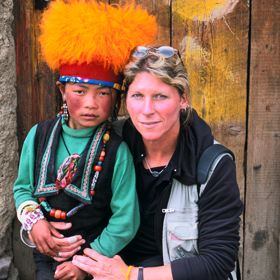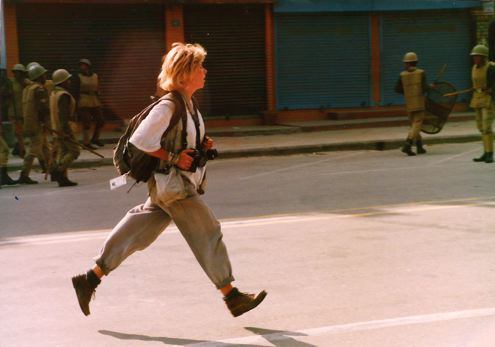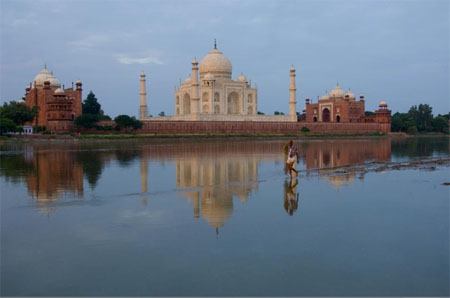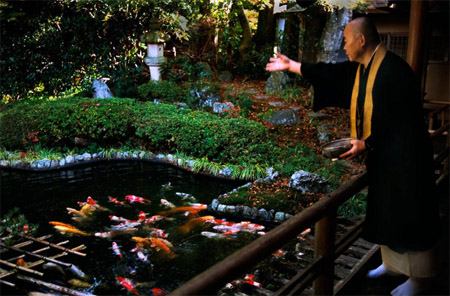 Alison Wright stands 5’2” and weighs in at a little over 100 pounds. She’s blond-haired and green-eyed pretty and, looking at her, “fierce” is probably not the first word you’d think of.
Alison Wright stands 5’2” and weighs in at a little over 100 pounds. She’s blond-haired and green-eyed pretty and, looking at her, “fierce” is probably not the first word you’d think of.
But fierce is what she is.
She’s fierce about her work. Fierce about life. Fierce about living it to the fullest.
She feels called to tell stories, mostly through the use of her camera, and nothing—not gunfire, bullies, disease, and crippling injuries—can stop her.
To date, she’s walked through hails of bullets during the revolution in Nepal, descended on the Gulf Coast in the wake of Katrina, booked a ticket to Sri Lanka as soon as she learned of the tsunami, and photographed children living in poverty throughout the world—all because she feels compelled to document the human condition.
Her work is everywhere: in books; in National Geographic; in photography exhibits and art galleries. Even right here on PeterGreenberg.com.
She’s traveled the planet on a one-woman quest to put a human face on refugees, government brutality, global warming, and poverty. The fact that her images are achingly beautiful doesn’t hurt.
It’s not every person who, in the course of 20 years, has had malaria, Giardia, dysentery, hepatitis, typhus, and parasites, not to mention the worm that made its home in Alison’s skull for two years and threatened to eat her brain.
 She’s flown across Arctic icebergs in a plane with no landing gear and can still point to the place on her cheek where the word “Nikon” is embedded due to a pummeling she and her cameras took from a Mongolian horse. Yet she’s never thought of putting that camera down and finding a safer way to make a living.
She’s flown across Arctic icebergs in a plane with no landing gear and can still point to the place on her cheek where the word “Nikon” is embedded due to a pummeling she and her cameras took from a Mongolian horse. Yet she’s never thought of putting that camera down and finding a safer way to make a living.
Maybe that’s because she doesn’t believe there is a safer way. She is very much of the Helen Keller school of thinking that “life is either a daring adventure or nothing.” In fact, when you question Alison about her choices, she answers in all sincerity (with a hint of impatience thrown in), “I feel like what I do is just not that interesting. It seems like it’s really quite pedestrian.”
Really? In what world would that be?
A year after starting Grateful Traveler, I’d call it the “world of the traveler” and Alison could be its ambassador.
 To me, travelers are people who lead with their hearts, take their cues from their gut and call home—not Minneapolis or Paris or Addis Ababa—but wherever they happen to be. And it stands to reason that if you feel comfortable everywhere, then no place should feel frightening or strange.
To me, travelers are people who lead with their hearts, take their cues from their gut and call home—not Minneapolis or Paris or Addis Ababa—but wherever they happen to be. And it stands to reason that if you feel comfortable everywhere, then no place should feel frightening or strange.
Alison claims she came by her world-citizen status while still in utero. Because her mother was an airline stewardess, Alison logged more miles before her birth than most people do in a lifetime. (As a very young girl, her wanderlust was so acute that her parents outfitted her with an ID bracelet so people could help her get home).
By age 9, Alison decided her goal on this planet was to lead an interesting life. At age 10, someone put a camera in her hands and she’d found her calling. Then a high school teacher let her in on a secret: One could make money taking pictures. Alison has never looked back.
Her years on the road have led her to places like Tibet, Nepal, India, Africa, Mongolia, the Arctic, and Afghanistan. But wherever she goes she finds common cause with the people. For Alison, it’s why she’s there. “If you are a documentary photographer it is just in your blood,” she says. “Telling stories is what feeds my soul. I love sinking my teeth into in-depth reporting.”
Check out Alison Wright’s slideshows on PeterGreenberg.com:
And the dangers? “I’m never deterred,” says Alison. “It’s like a marriage. In sickness and in health. I’ve had really bad times. But that just comes with it. What’s exciting is to see what’s coming next.”
 Perhaps if Alison had known what was coming next she never would have boarded a bus in Laos—a bus that was split in half by a logging truck as it rounded the bend on a curvy mountain road. Alison was sitting at the point of impact.
Perhaps if Alison had known what was coming next she never would have boarded a bus in Laos—a bus that was split in half by a logging truck as it rounded the bend on a curvy mountain road. Alison was sitting at the point of impact.
She broke her back and all her ribs; herniated her heart, lungs and intestines; had an arm that was bleeding out sewed up by a stranger who used an upholstery-sized needle, but no drugs or pain killers; lay for 10 hours in a country clinic with no medical intervention; then was put in the back of a truck for a seven-hour ride over muddy, bumpy roads to Thailand where she was put on the operating table and flat-lined.
Needless to say, this incident did change her life.
But in typical Alison style she says, “I sustained similar internal injuries to Princess Di.”
Then she wonders aloud if she survived while Diana didn’t because she had spent a lifetime overcoming difficulties and had more resources to draw on. “It’s not what happens to you, it’s what you do with it.”
And what Alison chose to do after her accident boggles the mind at the same time it touches the heart.
Find out more about Alison Wright next week in the Grateful Traveler series.
By Jamie Simons for PeterGreenberg.com.
Check out Alison Wright’s slideshows on PeterGreenberg.com:
Read more inspiring stories from the Grateful Traveler series:












